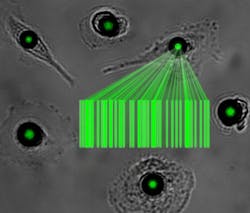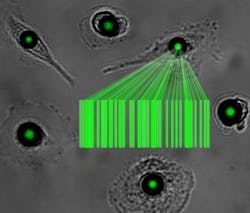Microlasers allow unprecedented cell tracking ability, with big implications for biomedicine
In a biomedicine breakthrough, researchers at the University of St. Andrews (Scotland) tracked a number of white blood cells by feeding them microlasers—a technique expected to allow new insights into how cancers spread in the body.
Related: First-ever single-cell biological laser excites imagination
The Soft Matter Photonics Group led by Professor Malte Gather of the School of Physics and Astronomy, in collaboration with immunologists in the University’s School of Medicine, found that by "swallowing" an optical micro-resonator, cells gain the ability to produce green laser light.
The technology may soon become a useful tool in biomedical optics: the spectral composition of the laser light generated by each cell is different and can be used to distinguish and track large numbers of cells over prolonged periods of time. In their initial study, the researchers demonstrated tagging of a few dozen human white blood cells and then tracked the cells for a day. In principle, the approach allows barcoding and reliably distinguishing up to several hundred thousand cells simultaneously.
Research groups around the world have worked on lasers based on single cells for several years now. However, all previously reported cell lasers required optical resonators that were much larger than the cell itself, meaning that the cell had to be inserted into these resonators. By drastically shrinking resonator size and exploiting the capability of cells to spontaneously take up foreign objects, the latest work now allows generation of laser light within a single living cell.
"This miniaturization paves the way to applying cell lasers as a new tool in biophotonics," says Gather. "In the future, these new lasers can help us understand important processes in biomedicine. For instance, we may be able to track—one by one—a large number of cancer cells as they invade tissue or follow each immune cell migrating to a site of inflammation."
Gather adds that the technology may lead to the ability to see where and when circulating tumor cells invade healthy tissue, providing insight into how cancers spread in the body and allowing scientists to develop more targeted therapies in the future.
The investigators put different types of cells onto a diet of optical micro-resonators. Some types of cells were particularly quick to "swallow" the resonators—macrophages internalized the resonators within five minutes. However, even cells without particularly pronounced capacity for endocytosis readily internalized the micro-resonators, showing that laser barcodes are applicable to many different cell types.
The micro-resonators used in this study were whispering-gallery-mode resonators, which are tiny plastic beads that trap light within a small volume by forcing it onto a circular path along the circumference of the bead. In the presence of an amplifying material, whispering-gallery resonators emit laser light, even under relatively weak optical pumping conditions. This renders them ideal for integration into live cells, as it prevents light-induced damage of the cells containing them.
The spectral composition of the laser light emitted by whispering-gallery resonators depends critically on the size and the refractive index of the plastic beads forming the resonator. Due to the inherent poly-dispersity (size variation) within a batch of whispering-gallery resonators, a large number of unique lasing spectra are obtained.
Full details of the work appear in the journal Nano Letters; for more information, please visit http://dx.doi.org/10.1021/acs.nanolett.5b02491.
Follow us on Twitter, 'like' us on Facebook, connect with us on Google+, and join our group on LinkedIn

